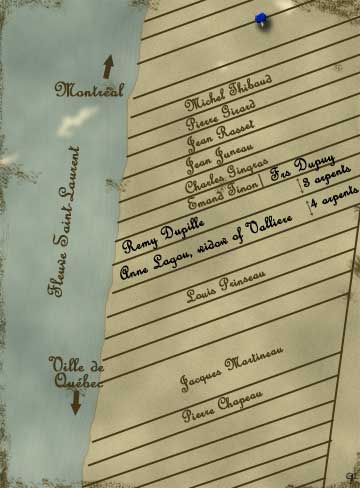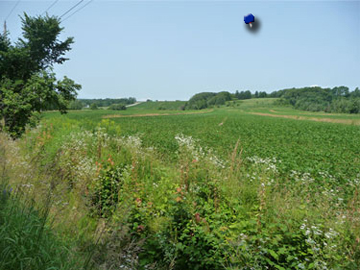Seigneurie.
1681 Recensement.
The census of 1681 reveals that Remy, age 40, resided in Saint-Augustin in the Seigneurie de Maure. He had three arpents of land under cultivation. A single man, he lived next door to the widow, Anne Lagou, who had five children. He was perhaps a close friend, having served as godfather to her four year old son Remy Vallière. Anne's husband Pierre Vallière had recently died and did not see the birth of his son Pierre in October of that year. Other of our ancestors, François Dupuy and Georgette Richer, lived two farms down.
Seigneurie de Maure.
The seigneurie, or land grant, was made by the king to Jean Juchereau de Maur and his brother Noel in 1647. They then allocated plots of land to settlers to develop. There was little growth until after 1663 and the further enhancement in 1672 of a communal moulin, or mill, built along a stream flowing from the Lac du moulin.

Remy and Anne's property was in the first rang, the most prized parcels that abutted the river which were usually the first to be distributed. The land grant was divided into long, narrow strips that maximized the number of available spots along the waterfront.
The river not only provided easy access to water needed for irrigation, but also served as a transit route. It would be many years before the King constructed a highway connecting the towns along the north shore of the Saint Lawrence River, but because everyone built along the shore a person traveling along the river passed every settler's home.
Relations With the Seigneurie.
As a censitaire, or settler, Remy had an obligation to clear the land for agricultural production. He was required to pay cens et rentes, a relatively small sum of less than ten percent of his revenue, to the Seigneur. Though the King required the men to defend the colony as part of a militia, there was no military debt to the seigneur as was found in feudal systems. A few days annually were also owed to the King to work on common needs such as roads or bridges.
For his part, the seigneur benefitted more from increased social standing rather than a fiduciary windfall. Any differences were settled by the Intendant. Censitaires were able to pass the land on to their children, but if it was offered for sale, the seigneur had the first opportunity to purchase it, or he would receive a twelfth of the sale price.

St-Lawrence River still hints at the ancient land divisions.
It was a peculiar aspect of life in the Canadian wilderness; the habitants on the whole ate better and had greater liberty than those living in France. With some effort they had the ability to climb the social ladder in a way that was not possible in Europe.
Most of the food they produced was for their own consumption. While they contributed to the markets to support the few towns, they did not generally export what they grew. Products such as animal hides, particularly beaver pelts, and seafood such as cod and eel, were sent back to France. There was plenty to be had from the land.
- Jetté, René, Dictionnaire généalogique des familles du Quebec des origines à 1730, Montreal: Les Presses de l'Universite de Montreal, 1983
- cite notaire Gilles Rageot
- Map image based on data from 1681 census and information from Société d'histoire de Saint-Augustin-de-Desmaures
- Ancestral Lands by Cynthia Petelle
